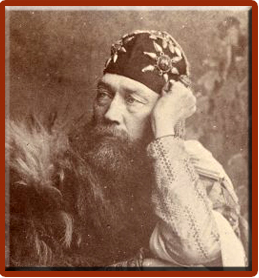
Taiping – The Old Capital of Perak
Published on Nil | by taipingphotogallery.blogspot.com
Taiping is known by many names – “City of Lasting Peace”, “City of Everlasting Peace”, “Tin Town”, “The Town That Tin Built”, “Town of Rain”, “Rain Town” or “Raintown” and “Town of Heritage” or “Heritage Town”.
 |
| Mao showing location of Taiping in Perak (1886) – “Notes on Perak” |
In his book, “British Malaya – An Account On The Origin and Progress Of British Influence In Malaya“, Sir Frank Swettenham gave a vivid account about old Perak before British involvement in the affairs of the state.
 |
| Perak Valley from Maxwell Hill (Bukit Larut) |
 |
| Impression of Perak by Sir Frank Swettenham |
 |
| Riding an elephant was the best mode of transport if you could afford it |
With part of the Larut Hills in the distant background, this was probably the general area where the towns of Taiping and Kamunting were established in 1874.
The establishment of Taiping and Kamunting towns is best described by Leonard Wray, the curator of Perak Museum, who wrote in the Perak Museum Notes No.3 published in 1894:
 |
| Leonard Wray…Read More |
 |
| “Tin Mines” by L.Wray, in Perak Museum Notes 3 (1894) |
 |
| “Tin Mines” by L.Wray, in Perak Museum Notes 3 (1894) |
 |
||
| “Tin Mines” by L.Wray, in Perak Museum Notes 3 (1894) |
 |
| Taiping 1878 |
 |
| Tupai 1878 |
The present Taiping town and the area stretching all the way to Kuala Sepatang (Port Weld) in the east and up to Kamunting in the north, were, at one time, the scenes of fierce fighting, rioting and devastation during the four Larut Wars that began in 1861.
Thirteen years later, on 20 January, 1874, the Pangkor Treaty officially marked the end of these protracted wars and the beginning of a new era of peace, development and prosperity for the region.
The Pangkor Treaty resolved
- the Sultan of Perak succession dispute;
- the rivalry between the Chinese Hai Sans and Ghee Hins over control of waterways for tin mining;
- and the acceptance of the British Residency system to advise on all State administration matters except Malay customs and religion.
With peace restored, the influx of new settlers to the rich tin mining areas of Klian Pau and Klian Bharu saw the local population grew from about 4,000 (1872-1873) to over 33,000 (end 1874).
 |
| In “British Malaya ” by Sir Frank Swettenham, 1907. |
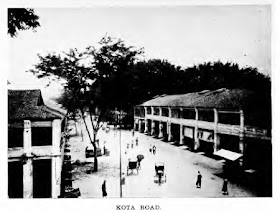 |
| Kota Road |
as it is today.
Taiping History
Timeline
– Che Long Jaffar discovered tin and opened a mine at a place called Galian Pao (Klian Pau, near where the museum now stands)
– The First Larut Wars (July)
– Che Ngah Ibrahim became Mantri of Larut
– The Second Larut Wars (June)
– The Third Larut Wars
– The Fourth Larut Wars
– Perak Armed Police
 |
| Col. Walker founder of Perak Armed Police in 1873 |
– Treaty of Pangkor (20 January)
– November, 1874, Sir Andrew Clarke (Governor of The Straits
Settlements) proclaimed James W. Birch (1874-75) ,
as 1st Resident of Perak, with Captain Speedy as Assistant Resident.
– (JW Birch was murdered in Pasir Salak on 2 November 1875)
– Captain Speedy , as Assistant Resident, was instructed to establish the townships
Taiping and Kamunting.
2nd British Resident – Sir Frank Athelstane Swettenham
( acting ,5 Nov 1875 – March 1876)
 |
| Sir Frank A. Swettenham |
British Assistant Resident’s Residence
The Secretary to Resident’s House
3rd British Resident – James Guthrie Davidson
(11 April 1876 – 31 March 1877 resigned)
4th British Resident – Sir Hugh Low (1 April 1877 – 31 May 1889)
 |
| Sir Hugh Low |
– Sir Hugh Low introduced steam engine and centrifugal pump for
tin mining
 |
| Steam engine at the Perak Museum
============================== |
Kamunting English School (Central School)
 |
| Central English School |
This was the first English school in the Federated Malay States and was located in Kamunting. It not only served as a centre of education for Larut district but also for other neighbouring districts such as Matang and nearby towns. The school was closed in the late 1930’s.
Taiping Gaol (Perak Prison)
Established in 1879, the Perak Prison was the main prison for long sentenced convicts of the Federated Malay States. It housed the Government Printing Office, a bakery and a laundry, where the prisoners did light work. Today, it is the country’s best example of a 19th century prison complex.
 |
| Taiping Gaol (Gaol is a variant spelling for jail and was popular during the 19th century.) |
 |
| Taiping Prison viewed across Main Road from Perak Meseum |
1880
Taiping Burnt
 |
| Big fire in Taiping |
Taiping was almost burnt to the ground during a big fire that destroyed almost all the wooden houses in town. The British were determined to make Taiping the administrative centre of Perak and began to rebuilt the town according to the gridiron system which was very popular then in Britain.
Taiping Hospital
The Chinese mining community founded the Yeng Wah (Chinese Pauper) Hospital in 1880 to combat an outbreak of beri-beri. It was taken over by the British administration and relocated to Main Road in 1881.
Maxwell Hill (now known as Bukit Larut)
 |
| Government bungalows at Maxwell Hill |
 |
| View from the Telekoms Towers (The Cottage) |
==============================
Clock Tower (Central Police Station and Fire Station)
Initially the clock tower was built of timber in 1881 “at a point about equidistant from the Chinese theatre, the market and other much frequented places“.
Some years later, it was fortified with chamfered slits for guns. The police station also doubled as a fire station. The first fire brigade in the Federated Malay States was made up of members of the Perak Armed Police and later the Malay States Guides established by Colonel Walker.
 |
| Taiping Clock Tower (2013) – junction Kota Road and Tupai Road |
Fort Carnarvon
Fort Carnavon is situated on a little hill just opposite the All Saints Anglican Church and beside the Taiping Prison complex. It was used to store ammunition supply belonging to the army and is still operational till today.
 |
| Fort Carnarvon (2013) |
Perak Club
 |
| Perak Club at Old Club Road |
Taiping Public Library
This government building at Kota Road was once the premises of the Chartered Bank of India, Australia and China, later known as the Standard Chartered Bank, which opened its Taiping agency in 1889. Today, it houses the Taiping Public Library.
 |
| Taiping Public Library along Kota Road |
==============================
King Edward VII School
 |
| Scource: Twentieth Century Impressions of British Malaya – 1908 |
 |
| Scource: Twentieth Century Impressions of British Malaya – 1908 |
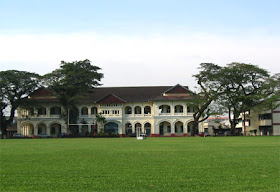 |
|
| King Edward VII School -Primary (2008 pic) |
Perak Museum
 |
| Scource: Twentieth Century Impressions of British Malaya – 1908 |
 |
| Perak Museum (2008 pic) |
| Perak Museum (2012 pic) |
District Office Building
==============================
Central Market
The Taiping Market consists of two buildings, the Old Market built in 1884 and the New Market built in1885, each one a timber post and truss structure, “220 feet long by 60 feet wide, concrete floor and iron roof”, with a middle clerestory.
Possibly the largest non-indigenous historic timber structure in the country, the Taiping Market is also Malaysia’s best preserved example of a major 19th century market building.
The markets were designed by the colonial Public Works Department (PWD) and were divided into different zones catering to the Malay and other communities.
The old market, built in 1884, stretches from Main Road (Jala Taming Sari) to Kota Road (Jalan Kota) which comprised the fish and fruits market and the pork market.
 |
| The Fish and Fruits Market fronting Main Road (Jalan Taming Sari) |
 |
||
| The Pork Market fronting Kota Road |
 |
| Another view of the Pork Market fronting Kota Road |
 |
| Inside the Pork Market |
 |
| Ceiling of the Pork Market |
 |
| Inside the Pork Market |
The new market, built a year later in 1885, stretches from Kota Road to Theatre Road (Jalan Paggung Wayang). It comprised two buildings – a hawker centre popularly known by the locals as Siang-Malam and a building that ha s several sections selling fresh vegetables, meat, chicken and beef.
 |
| Popularly known by locals as Siang-Malam |
———————————————————-
Post and Telegraph Office
The first post office in the Federated Malay States built in 1884, to replace an earlier timber building. The post from Taiping was carried by a relay of runners and ponies.
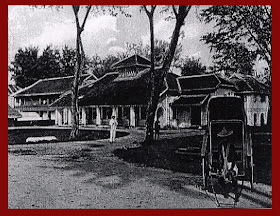 |
| Post Office and Telegraph Office on the right |
 |
| Telegraph Office at Barrack Road |
Taiping Lake Gardens
 |
| Scource: Twentieth Century Impressions of British Malaya – 1908 |
| Taiping Lake Gardens (Taman Tasik Taiping) |
 |
| Taiping Lake Gardens with Maxwell Hills (Bukit Larut) in the background |
==============================
Taiping Race Course
Perak Golf Club
Taiping-Port Weld Railway
“The first railway undertaken was a line of only eight miles from Taipeng, the mining centre of Larut, to a point called Sa-petang (afterwards named Port Weld), on a deep water inlet of the Larut River navigable for small steamers. That line was constructed by two divisions of Ceylon pioneers, lent by the Government of Ceylon, and was completed in 1884.”
The main reason to build the railway was that it was the most efficient way then to export tin and tin ore and to import foodstuffs and mining equipment. It also provided cheap and fast transport for the vast numbers of Chinese labourers who entered and leave the state in search of work at the tin mines.
 |
| Scource: Twentieth Century Impressions of British Malaya – 1908 |
All Saints’ Anglican Church
The first Anglican church in the Malay States opened in 1886. The timber building was designed by G.A Lefroy and the site donated by W.M Drummond, a planter from Shanghai. In 1898, the graveyard was already ‘much besprinkled with the tombstones of many a young man stricken down in the heyday of youth, or British official who, after spending the best years of his life in the service of the State, has failed to gain his pension, and now lies buried here…’
 |
| All Saints Anglican Church – Kota Road (2013) |
 |
| Original stained glass window |
 |
| Celebrating 50 years (1887 – 1937) plague on the organ |
– Kwantung Association
Founded in 1887 by Chung, Keng Quee and others as an association of people from Kuangtung (Guangdong) province in South China.
 |
| Kwangtung Association North Perak Taiping at Jalan Tokong |
 |
| Kapitan Chung Keng Quee Scource: Twentieth Century Impressions of British Malaya – 1908———————————————————- |
Ho-hsien-ku Temple
Ho-hsien-ku Miaou or Temple for Ho, the Immortal Lady of the Eight Immortals. Lady Ho is believed to have been a native of Tseng-ch’eng county, Kuang-Chou prefecture. The temple was probably built at about the same time as the Kwangtung Association as it was located just next door to it.
 |
| Temple Ho-hsien-ku at Jalan Tokong Taiping with Maxwell Hills in the backdrop |
Tseng Lung Hakka Association
Founded around 1887, the Tseng Lung hui-kuan is the association of people from Tseng ch’eng and Lungmen counties of Kuang-chou prefecture in South China.
 |
| Tseng Lung Association – Market Road |
Perak Government Gazette
This was the official annual publication of the Perak Government and was printed by the Government Printing Office located at the Taiping Gaol or Prison.
5th British Resident – Sir Frank Athelstane Swettenham
( 1 June 1889 – 30 June 1896)
 |
| Sir Frank Athelstane Swettenham |
Treacher’s Girls’ School (Treacher Methodist School)
 |
| Treacher’s Girls’ School (Treacher Methodist School) |
 |
| Treacher’s Girls’ School (Treacher Methodist School) |
 |
| Treacher Methodist School (2008) |
Freemason lodge
———————————————————-
Chartered Bank
This government building was once the premises of the Chartered Bank of India, Australia and China, later known as the Standard Chartered Bank, which opened its Taiping agency in 1888. Today, it houses the public library.
“The year 1889 was notable in the history of the protected States, for in that year Sir Hugh Low retired from his post as Resident of Perak. … and the first bank, a branch of the Chartered Bank of India, Australia, and China, was opened at the head-quarters of the Perak Government.”
The Esplanades
New Club
Nawab Din
Nawab Din was an ex-police personnel under Col. Walker. On his retirement, Nawab became a Master Tailor. It was in this building that he produced uniforms for the army and police. He became wealthy and well known as a textile tycoon. This building at Main Road is now abandoned.
 |
| Nawab Din – 1892 |
On 17th November 1893 Mrs. Frank Swettenham officially declared the Taiping Lake Gardens a public garden.
A water fountain was donated by the Chinese mining community and placed in the centre of the gardens.
Mr Scott was credited for the beautiful layout of the gardens and Colonel Walker also played a very significant role in helping to establish the gardens from abandoned mining lands.
Town Rest House
 |
| Rest House |
Malayan Indian Association
 |
| Malayan Indian Association Building along Main road |
Perak Pioneer newspaper (4th July)
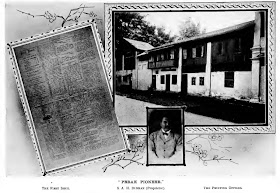 |
| Perak Pioneer Scource: Twentieth Century Impressions of British Malaya – 1908 |
Perak Varthamanan
This Tamil paper was published weekly.
Seri Perak Newspaper
This weekly newspaer was published in Malay.
Government Offices Building
In 1895, the construction of a new Government Office building was initiated to replace the old District Office building built in 1883. This new Victorian-styled building “which is well designed and constructed provided accommodation for a Council Chamber, Offices for the Secretariat, Treasury, Audit, Education and Forest Department”. The building was completed in 1897 and began operations in 1898. Today, it is the premises of the Larut-Matang-Selama District and Land Office.
 |
| District and Land Office Building (2013 photo) |
 |
| District and Land Office Building – back of building along Kota Road(2013 photo) |
 |
| District and Land Office Building – back of building along Kota Road(2013 photo) |
6th British Resident – Sir William Hood Treacher
( 1 July 1896 – 12 December 1901)
 |
| Sir William Hood Treacher |
Malay State Guides
 |
||||||
Malay State Guides replaced Perak Armed Police in 1896
————————— |
Jajahan Melayu newspaper
Kota Mosque
 |
| Kota Mosque or Malay Mosque |
This is the oldest mosque in Taiping and was built in brick in 1897. It has an intriguing six-sided facade. It was originally a Hanafi mosque used by the Indian Muslim community of Kota. In the early 20th century it was given over to the Malay community and called the ‘Malay Mosque’ (Masjid Melayu).
Taiping Teachers’ College
Taiping Convent School
In 1889, the first convent was started in nearby Klian Puah by three sisters from the convent in Penang. The class and orphanage in Taiping were upgraded when the present school building at Kota Road opened in 1938.
In May 1941, the British requisitioned it for a large military hospital but in December it was taken over by the Japanese. Towards the end of the war, the Taiping Convent became the headquarters of the Japanese military administration, the Gun-sei Kan-bu.
 |
| Convent School (2008) |
Saint Louis Church
Built about the same time as the convent School, this church is one of the finest Catholic churches in the country.
Ceylon Association
“The Ceylonese Tamils came to Perak in the 1880s to join the civil service and build the railways. In 1889, they founded the Ceylonese Association and put up the building two years later.”
 |
| Ceylon Association (picture taken in 2008), Station Road |
7th British Resident – Sir John Pickersgill Rodger
(13 December 1901 – 9 February 1904)
Khalsa Diwan – Punjabi Association
Punjabi Association was founded in 1903 by the Sikhs of the Malay States Guides with the aim of improving the social position of the Sikhs in Malaya.
==============================
8th British Resident – Sir Ernest Woodford Birch
( 10 February 1904 – 5 March 1911)
 |
| Sir Ernest Woodford Birch |
9th British Resident – Sir Henry Conway Belfield
(6 March 1911 – 15 December 1911)
10th British Resident – Oliver Marks
(15 December 1911 – 9 August 1912)
11th British Resident – Colonel William James Parke Hume
(9 August 1912 – 12 August 1912)
12th British Resident – Sir Reginald George Watson
(12 August 1912 – 17 September 1919)
St. George’s Institution
This Catholic boys’ school was established in 1915 and 13 years later the original building was extended with a wing on each side. During the Japanese Occupation, the school served in turn as Nippon-Go Gakko (Japanese school), Kempetai (Japanese military police) base and Japanese officers’ hotel.
Read More at SGI official website
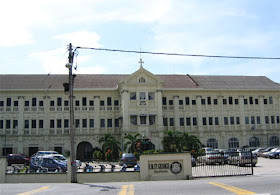 |
| SGI (2008) |
Taiping Swimming Club
13th British Resident – Sir William Edward Maxwell
(17 September 1919 – 12 September 1920)
 |
| Sir William Edward Maxwell |
14th British Resident – Colonel William James Parke Hume
(29 June 1920 – 13 July 1921)
Coronation Park
15th British Resident – Sir Cecil William Chase Parr –
(4 July 1921 – 20 December 1925)
16th British Resident – Oswald Francis Gerard Stoner –
(20 December 1925 – 6 June 1927)
17th British Resident – Henry Wagstaffe Thomson –
(6 June 1927 – 1929)
Lord Subramanian Temple
This temple at Kota Road was built in 1928 to replace the old temple that was located at the foot of Bukit Larut. The original temple was built in 1895.
Peace Hotel
Built in 1928, the Peace Hotel was originally the residential home of Mr. Toh Kay Beng who was a businessman who owned Taik Ho & Co. dealing in European commodities. He also set up a Chinese rice wine brewery called Guan Ho Sdn. Bhd. His son Toh Eng Hoe inherited this building which was later sold to a Mr. Chew. After the World War II, it became the headquarters of Lee Rubbers. The building was converted into an office and the upper floor into a rest house. In 1959, the building was acquired by a Mr. Teoh and his business partner Mr. Ong. It was converted into a coffeeshop with the first floor turned into a hotel. It is situated at the junction of Jalan Iskandar and Jalan Panggung Wayang.
18th British Resident – Charles Walter Hamilton Cochrane
(1929 – 1930)
———————————————————-
———————————————————-
 |
| Taiping Aerodrome (2008 pic) |
19th British Resident – Bertam Walter Elles (1931 – 1932)
1931
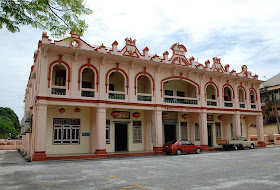 |
| Hokkien Association along Kota Road |
==============================
20th British Resident – Sir Geoffrey Edmund Cator (1933 – 1939)
Coronation jetty at Taiping Lake Garden
 |
| 1932 Coronation jetty at Taiping Lake Garden
============================== |
1937
==============================
1939
21st British Resident – Marcus Rex ( 1939 – 1941)
Japanese Governors
1942 – 1943 – Kubata Shun
1943 – 1945 – Takajiro
1945 – Nomura
1945 – Oda
The Taiping War Cemetery has more than 850 World War II casualties including more than 500 who remain unidentified. It is the final resting place for Allied personnel who were killed during the Malayan Campaign and the Japanese occupation of Malaya. Servicemen who died after the war or during their posting in northern Malaya prior to the Malayan Emergency are also interred here.
The cemetery is located along Jalan Bukit Larut, Taiping, Perak, Malaysia and was erected and maintained by the Commonwealth War Graves Commission.
 |
| Taiping War Cemetery- Christains section |
 |
| Taiping War Cemetery- non-Christains section |
During this period there were eight British Resident Commissioners in Perak
Last British Advisor – Sir Ian William Blelloch
A little footnote on Taiping:
Taiping in Perak was originally called Klian Pauh, a name derived from ‘Mine’ and a small variety of mango.
Following the discovery of tin there, the influx of Chinese from China (the Ghee Hin and the Hai San clans), the Larut Wars and the 1874 Pangkor Treaty, it was re-named ‘Taiping’ by the Hai San which in Chinese means ‘Heavenly Kingdom of Great Peace’.
Nearby Klian Baharu was renamed by the Ghee Hin as Kamunting.
The 1st railway track in Malaya was built from Port Weld to Taiping.
“What is the use of a book,” thought Alice, “without pictures or conversations?”… Taiping Photo Gallery shows off images and everything that is Taiping. Taiping was the Old Capital Of Perak. Taiping literally means Town of Everlasting Peace. I Love Taiping and You Will Too.
















